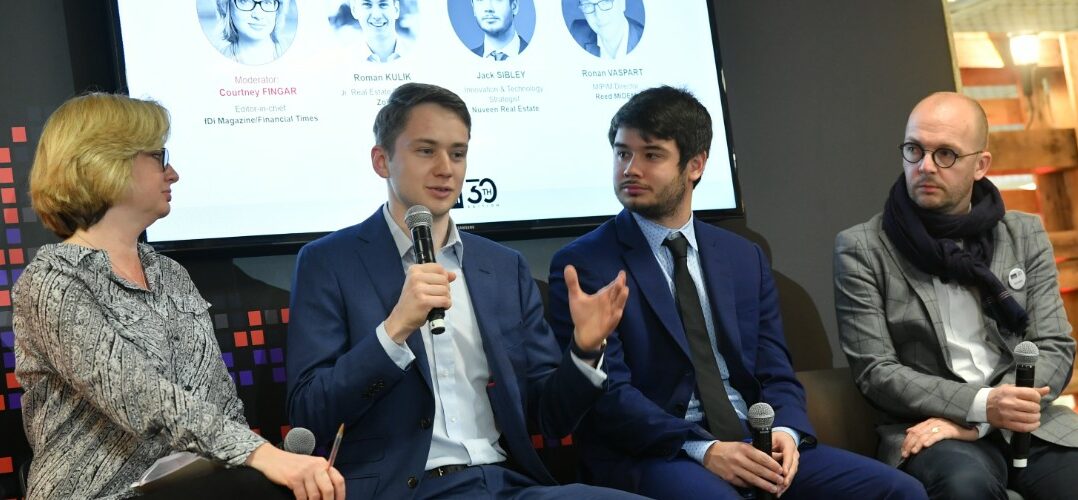Labour and skills shortages have become one of the top three strategic challenges facing occupiers, according to CBRE’s EMEA Occupier Survey 2019, which focuses on Optimising Human Skills.
Real estate’s drive for talent – including attracting, developing and retaining new recruits – comes ahead of cost reduction as a strategic challenge, and only behind economic uncertainty and disruption by technology.
« It is about focussing on the experience of your employees, as well as adapting to structural changes taking place in the industry »
Not only is it about focussing on the experience of employees, but also about adapting to structural changes taking place in the industry – the real estate sector included.
Real estate companies becoming tech companies
One of the key structural changes taking place in real estate is the growth of tech. Aakash Ravti, Co-Founder & Chief Growth Officer of Spaceti, the winner of the MIPIM 2019 Startup Competition, predicts: “More and more real estate companies are going to become tech companies that happen to be in the real estate industry.”
According to the PwC report Talent Trends 2019, “organisations desperately need tech-savvy leaders and employees … [people]who can harness innovative thinking, form the right strategies and apply the systems and tools that best fit the needs of the business.”
As structures change, so do skills. For example, only about half of people currently working at CBRE are chartered surveyors.
Need to represent all users of the built environment
Soft skills, akin to those in hospitality, are becoming as important as tech skills in the real estate industry, as the sector moves to be more of a service – one connected to the community – rather than purely a building asset.
“As an industry, it’s becoming increasingly important for us to be representative not just of our clients, but of everyone impacted by the built environment,” said Jack Sibley, Innovation & Technology Strategist, Nuveen Real Estate, during the Closing Remarks at MIPIM 2019 (top photo, second from right).
“We need more diversity of thought, to bring in people from outside the industry, to make real estate more representative of society. The real estate sector makes key decisions that influence the daily lives of all city users. You can’t escape the built environment; unlike a website where you can log off, you cannot stop experiencing real estate.”
Meeting the expectations of young talent
Sabine Desault, Executive Director of Gecina, the Paris-based real estate investment trust, opened the inaugural Young Leaders Summit at MIPIM 2019 by saying that investing in young talent is about “imagining and building a more sustainable and connected city”.
This is because, she said, the younger generation is more aware of environmental issues and “they expect tomorrow’s cities to be sustainable and inclusive”.
Gecina dedicates 6% of its payroll to training, while its many initiatives include supporting the Chair in Real Estate & Sustainable Development at ESSEC Business School in Paris, whose students were involved in reporting on the MIPIM Young Leaders Summit.
Real estate as a tool to attract talent
As strategies for skills, space and service converge, “optimising human capital is becoming the overriding aim of occupiers’ property locations,” says CBRE’s EMEA Occupiers Survey. This is reflected in:
- Procurement and fit-out – 68% of those surveyed see employee engagement as a key part of their corporate real estate strategy.
- Flexible space – 28% use flex space as a way to attract and retain talent.
- User experience – 37% of user experience programmes contain community elements.
- Technology – 34% see labour and skills shortage as a key operational challenge.
Changes in the workplace have also seen wellness emerge as a key feature in this optimisation of human capital. Wellness is a core concept at CBRE’s new UK headquarters in London, due to open at the end of 2020.
“The human-centred design prioritises employee wellbeing by maximising natural daylight throughout, and includes two on-site wellness studios, a dedicated spin studio, around 300 cycle rack spaces and returning new parent facilities,” says CBRE, who produced a wellness white paper in 2016.
“The biggest threat to the real estate industry is itself”
During the Closing Remarks of MIPIM 2019, Sibley said that “the biggest threat to the real estate industry is itself”.
“Equal time needs to be spent focussing on structural factors as on more typical real estate market factors such as pricing and cycles”
“Structural changes in the industry have historically been slow enough to keep up with as and when they happened,” said Sibley. “Now the pace of change, and the need for change, is accelerating to a point where equal time needs to be spent focussing on structural factors as on more typical real estate market factors such as pricing and cycles.”
Earlier this year Sibley co-authored a report with MIPIM on Engaging the Future, the theme for MIPIM 2019. The report, which had a special focus on the megatrends of demographics, sustainability and technology, concluded:
“Those who position themselves defensively in light of these structural changes will survive in the short term, but those who can create opportunity will be able to drive true value in tomorrow’s world and fully engage the future.”
Where is your company positioned?



